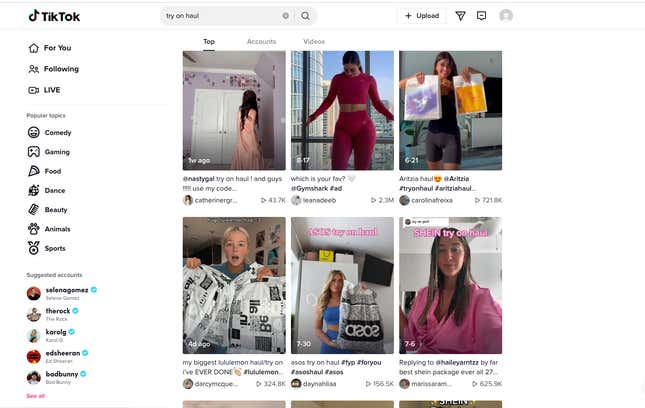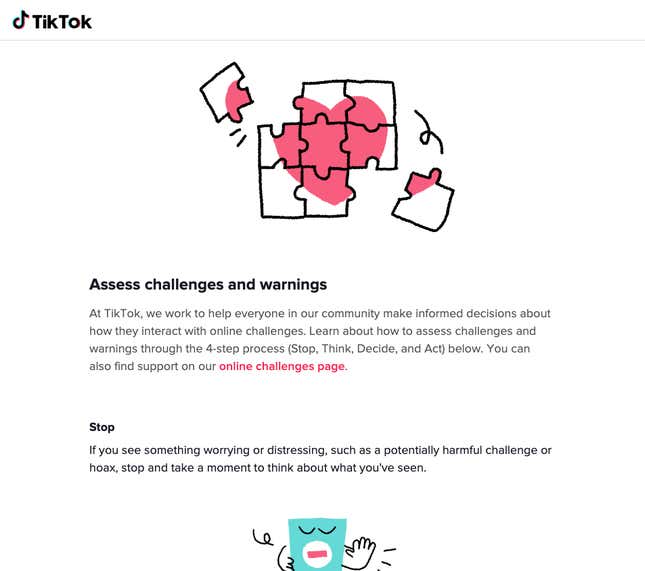Thanks to the internet, sometimes unnecessary planetary damage is gleefully filmed and proudly posted. On TikTok, the ever-growing social media behemoth that teens love, trends come and go quickly—but some of them can’t vanish soon enough. Here are a few of the worst bad-for-the-Earth fads that have swept through the platform. Please don’t try any of these.
8 TikTok Trends That Are Terrible for the Environment
Sometimes, vying for "viral" has seriously destructive consequences.
Frog (H)army

A TikTok account racked up millions likes, followers, and views on so-called “frog army” posts, which alarmed biologists earlier this year. User @thinfrog’s videos appear to catalogue a person collecting amphibian eggs from various water bodies, raising those eggs into a swarm of tiny froglets, and then unleashing them into the wild.
The veracity of the TikTok is unconfirmed, and many commenters have expressed skepticism that the videos are real. Some have gone as far as to identify parts of the footage that seem to be from years-old YouTube videos. But real or hoax, the popularity of the frog army videos concerned experts.
Initially, @thinfrog’s videos seemed to inspire others. Older comments on the posts are chock-full of people asking where they could get their own frog eggs to raise and release. And at least one other TikTok user posted similar content, claiming to have released 100 million ladybugs in New York’s Central Park.
Relocating and releasing animals into the wild without proper approval and permits is a huge environmental risk. Moving frogs, even between ponds in the same zip code, can be extremely detrimental to the local ecosystem and amphibians as a whole. Some species of frog, like American bullfrogs, are considered invasive around the world. They are voracious predators that spread fast and often carry a deadly fungal disease with them. In fact, they’re so bad that bullfrogs are considered one of the 100 worst invasive species worldwide.
And even if the species in the frog army videos isn’t invasive, they could still easily pass along disease to new ponds and streams.
“It makes me cringe,” Tierra Curry, a conservation biologist at the non-profit Center for Biological Diversity told The Guardian. “Instead of helping, [this TikTok user is] actually hurting the animals they’re releasing and all the animals in the environment that they’re releasing them into — it’s creating a vector for disease and invasive species.”
The Big Dig
Digging in sand at the beach is usually innocuous fun. But on TikTok, bigger is better if you’re trying to rack up views. In the platform’s apparent beach excavation trend, tiny plastic shovels and other sand castle accoutrements are replaced by large shovels and a determination to go deep.
Unfortunately, digging a massive pit on the beach and leaving it there has downsides—both for human safety and the ecosystem. Large holes can be a fall hazard for other beachgoers and can trap sea turtle hatchlings and other beach wildlife, according to multiple news reports from local Florida media outlets.
If you do opt to dig a hole, please fill it in—if not for humanity, then for the turtles’ sake.
The Even Bigger Dig
If digging a hole at the beach and leaving it there is bad, you can bet doing the same thing in the middle of the jungle on an even grander scale is...also bad.
A subset of “primitive technology” videos have popped up on TikTok (though most seem to have been originally posted on YouTube) with hundreds of thousands of views. In the videos, a small group of men seem to use hand tools to carve out entire swimming pools, living rooms, underground lairs from the previously undisturbed forest floor.
Again, the veracity of these videos is widely disputed, and it’s likely the TikToks aren’t representative of all of the work, equipment, and people power that goes into these constructions. However, regardless of how it’s been done, the end result is a massive pit with no drainage system and a whole lot of soil displacement and erosion—all in the name of clicks.
Resin Repercussions
The human tendency to create art is a wonderful thing, but all that creative power can sometimes be not-so-beautiful. Resin art uses epoxy resin (a petroleum-based plastic-like product) to make everything from sculptures to keychains, furniture, wall art, and more. It starts out in a pourable, liquid form and can be “cured” into a mesmerizing solid. Watching flowing resin be poured and molded is hypnotizing, and the final product can be astounding, hence the proliferation of resin artists on TikTok.
But in both the solid and liquid stages, resin has big environmental consequences. Uncured resin emits toxic fumes and should only be handled using proper safety equipment in a very well-ventilated space. It’s also toxic to aquatic life and can cause a lot of harm if it’s dumped down the drain (or in the trash) in its liquid form. Uncured epoxy can only be safely offloaded via professional, hazardous waste disposal services.
When it’s cured, solid resin becomes just as indestructible as other plastics. It doesn’t readily break down. Instead, it’s destined to eventually sit in landfills, unchanged for thousands of years.
“I am not one to judge any artist’s medium choice, but I do worry that because resin crafts have become popular lately, we will eventually see a lot more resin in landfills than we typically do,” Alaina Wood, a solid waste disposal expert, told Mashable.
“I hope that people aren’t immediately throwing away resin crafts, but it is naïve to think resin crafts won’t eventually be thrown out,” she added.
Thankfully, it seems that as the popularity of resin art continues to grow, so too does awareness of the issues with it. In their report, Mashable pointed out that a new trend has emerged alongside resin art, TikTok-ers (like Wood) are encouraging each other to use more sustainable materials.
Fast Fashion Hauls

Fast fashion is an environmental catastrophe. Clothes manufacturing is a massively polluting industry, and when companies manipulate people into chucking out last year’s threads for the newest trends, they’re contributing to a growing waste crisis.
Sadly though, one of the most enduring trends on TikTok are try-on “hauls,” where creators receive packages full of clothing from a fast fashion retailer and then review each item on video. Often, this type of content is sponsored, so creators are paid to give positive endorsements of the (usually) cheap clothing.
The impact is multi-fold. Obviously, fashion influencers are personally going through a lot of clothes. But functionally, these videos are nothing more than advertisements meant to get more people buying more stuff.
Wasteful Theft

Lots of problems emerged when “devious licks” started gaining steam on TikTok last year. For one, the stealing challenge led to multiple teens facing criminal charges. Devious licks got kids to steal large quantities of covid-19 tests, plastic spoons, and disposable masks. And there were reportedly larger heists, too: soap dispensers, lab equipment, even toilets.
TikTok eventually removed almost all of the devious lick videos for content violations and banned related hashtags and search terms. But lots of the damage was already done.
Schools had to replace everything stolen, and the fate of the original items is mostly a mystery. Likely, much of the contraband that wasn’t returned was trashed.
Orbeez :(
Just because “water beads” aren’t plastic, doesn’t mean it’s fine to dump them everywhere. The expanding colorful spheres are made from super absorbent polymer gels, and do technically biodegrade over time—in fact, they were initially intended and marketed as a gardening and agricultural tool, to help retain soil moisture. But time is relative, and two to five years (maybe even up to 10!) is a long wait while polymer beads build up in the environment.
Just as they can pose a choking and obstruction threat to children, Orbeez and similar water beads can also be a risk to wildlife that might ingest them accidentally.
Plus, there’s the damage they can reportedly do to sewage systems as people opt to fill their bathtubs with them. Water beads are fun in certain contexts, and can safely enjoyed in small quantities, contained in your home, but maybe reconsider intentionally pouring them outside.
Gizmodo is begging you to think before you ‘beez.
Toilet Trash
Ok, this one is pretty self-evident. The “trend” is literally people dumping stuff down the toilet. Is it a meta commentary on consumption? An act of performance art?
Whatever the motivation, please don’t fill your toilet bowl with otherwise usable food for internet clout. And please, dear god, don’t just pour huge quantities of corrosive, toxin-filled cleaning products down the drain.
Seriously, cleaning products can be dangerous stuff—for human health and for the environment. They’re not intended to be used, or disposed of, in high volumes, and mixing them together can be deadly.
I can’t pretend to understand why people were/are doing this, I just wish I could erase it from the internet and my brain. Of all the questionable TikTok trends, I swear this is the one that’s going to become my Joker origin story.